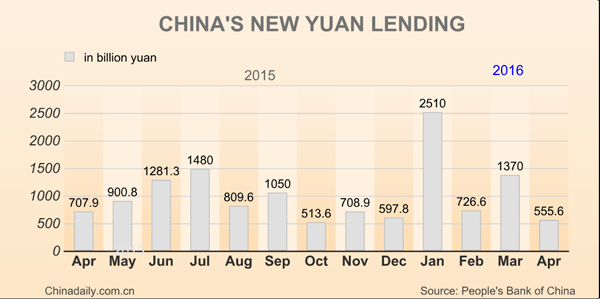 |
|
China's new yuan-denominated lending in April fell to 555.6 billion yuan ($85.23 billion), 152.3 billion yuan less than a year earlier, official data showed Friday. |
BEIJING - China's new yuan-denominated lending in April amounted to 555.6 billion yuan ($85.23 billion), 152.3 billion yuan less than a year earlier, official data showed on Friday.
The data went far below market expectations as new yuan-denominated lending in March soared year on year by 188.3 billion yuan to 1.37 trillion yuan.
The decline reflects policymakers' intention to contain leverage, according to a research report by Nomura Securities.
The April data indicates that the surge in credit supply in the first quarter was unsustainable, and the government has prioritized supply-side reforms and deleveraging over growth driven by further credit extension, Nomura said.
Despite this, the total outstanding lending in both yuan and non-yuan currencies stood at 104.27 trillion yuan at the end of April, up 13.1 percent year on year, the People's Bank of China said in a statement on its website.
The M2, a broad measure of money supply that covers cash in circulation and all deposits, rose 12.8 percent year on year to 144.52 trillion yuan at the end of April.
The M1, a narrow measure of money supply that covers cash in circulation plus demand deposits, rose 22.9 percent year on year to 41.35 trillion yuan, the statement said.
The M0, the amount of money in circulation, stood at 6.44 trillion yuan, a year-on-year increase of 6 percent. The central bank drained 24.8 billion yuan of cash from the market in April.
Newly-added social financing, a measurement of funds that non-financial firms and households get from the financial system, fell to 751 billion yuan in April from March's 2.34 trillion yuan, and also 307.2 billion yuan less than the same period last year.
At the end of April, yuan-denominated deposits stood at 141.95 trillion yuan, up 12.9 percent from a year ago. In April alone, yuan-denominated deposits gained 832.3 billion yuan, 38.8 billion yuan less than a year ago.
In the Jan.-April period, total outstanding deposits in both yuan and non-yuan currencies rose 12.6 percent year on year to 146.26 trillion yuan at the end of April.
"We maintain our view that monetary policy will remain accommodative but that easing will be more cautious and take the form of targeted easing," Nomura said.
Weak credit growth suggests there will be a pause in monetary easing, with no more rate cuts likely this year, said Tom Orlik, chief Asia economist at Bloomberg.
"Slowing loan growth is undoubtedly the right thing to do but it cannot be done without facing significant risks," Orlik said, citing growth's strong dependency on credit as one of the risks.
Every one percentage point drop in the pace of credit growth could drive a 0.5-percentage-point drop in GDP growth, according to Bloomberg Intelligence Economics' calculation.
China's economy expanded 6.7 percent year on year in the first quarter, slowing further from the previous quarter. Facing continued economic headwinds, China has made supply-side reform an economic priority.
